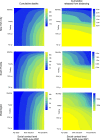Modeling serological testing to inform relaxation of social distancing for COVID-19 control
- PMID: 34862373
- PMCID: PMC8642547
- DOI: 10.1038/s41467-021-26774-y
Modeling serological testing to inform relaxation of social distancing for COVID-19 control
Abstract
Serological testing remains a passive component of the public health response to the COVID-19 pandemic. Using a transmission model, we examine how serological testing could have enabled seropositive individuals to increase their relative levels of social interaction while offsetting transmission risks. We simulate widespread serological testing in New York City, South Florida, and Washington Puget Sound and assume seropositive individuals partially restore their social contacts. Compared to no intervention, our model suggests that widespread serological testing starting in late 2020 would have averted approximately 3300 deaths in New York City, 1400 deaths in South Florida and 11,000 deaths in Washington State by June 2021. In all sites, serological testing blunted subsequent waves of transmission. Findings demonstrate the potential benefit of widespread serological testing, had it been implemented in the pre-vaccine era, and remain relevant now amid the potential for emergence of new variants.
© 2021. The Author(s).
Conflict of interest statement
B.A.L. reports grants and personal fees from Takeda Pharmaceuticals and personal fees from World Health Organization outside the submitted work. A.N.M., K.N.N., J.S.W., C.Y.Z., and D.D. declare no competing interests.
Figures





Update of
-
Modeling serological testing to inform relaxation of social distancing for COVID-19 control.medRxiv [Preprint]. 2020 Nov 17:2020.04.24.20078576. doi: 10.1101/2020.04.24.20078576. medRxiv. 2020. Update in: Nat Commun. 2021 Dec 3;12(1):7063. doi: 10.1038/s41467-021-26774-y. PMID: 32511519 Free PMC article. Updated. Preprint.
References
-
- COVID-19 Map [Internet]. Johns Hopkins Coronavirus Resource Center. https://coronavirus.jhu.edu/map.html. Accessed 12 Nov 2020.
-
- Aylin, W. H. S. About 95% of Americans have been ordered to stay at home. This map shows which cities and states are under lockdown [Internet]. Business Insider. https://www.businessinsider.com/us-map-stay-at-home-orders-lockdowns-2020-3. Accessed 16 Apr 2020.
-
- Kaplan, J., Frias, L. & Morgan, M.-F. A third of the global population is on coronavirus lockdown—here’s our constantly updated list of countries and restrictions [Internet]. Business Insider. https://www.businessinsider.com/countries-on-lockdown-coronavirus-italy-.... Accessed 20 Apr 2020.
-
- American Enterprise Institute - AEI. National coronavirus response: a road map to reopening [Internet]. https://www.aei.org/research-products/report/national-coronavirus-respon.... Accessed 14 Apr 2020.
Publication types
MeSH terms
Grants and funding
LinkOut - more resources
Full Text Sources
Medical

